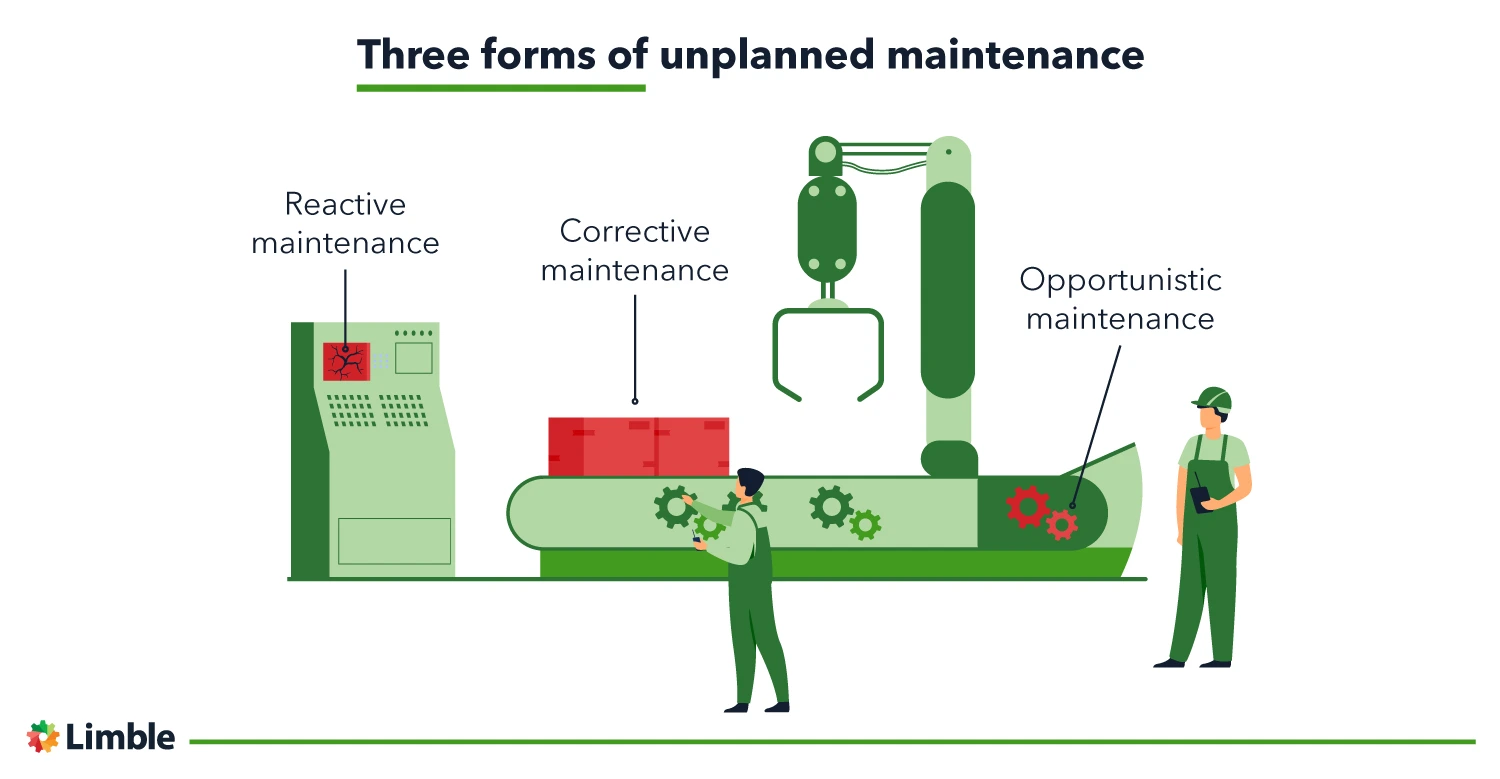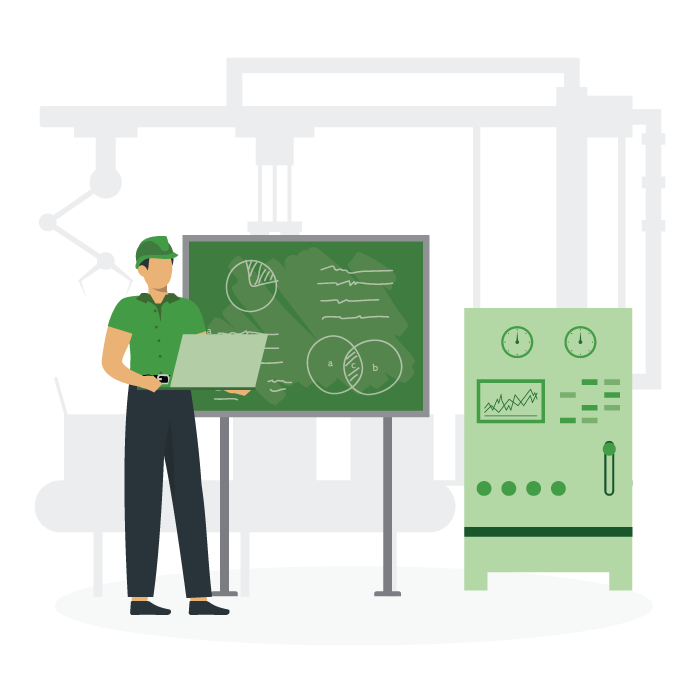Unplanned Maintenance
Everything you ever needed to know about unplanned maintenance.
What is unplanned maintenance?
The dictionary defines unplanned as something unexpected or unintentional, with related words including abrupt, spontaneous, and unannounced. When used within maintenance, it refers to an unexpected issue occurring with no forewarning and, therefore, no ability to moderate the outcome. No tasks will exist in the maintenance plan that might have averted the event, and it’s unlikely that spares provisioning has been considered unless through a lucky coincidence.
Is unplanned maintenance the same as unscheduled maintenance?
No, it’s a different concept. When a maintenance task is called unscheduled, it refers to a task that exists in the maintenance plan but is not scheduled for acquittal at that particular time. So the task is planned but not called for completion, making any immediate acquittal “out of schedule.” Unscheduled maintenance is often carried out for convenience.
A simple example might be a task to measure a brake disc to ensure it’s above a minimum thickness. If you need to carry out corrective maintenance on a brake caliper due to a leaking hydraulic seal, it makes no sense to repair just the seal. While you have the brake assembly dismantled, you might as well carry out any other allied tasks in that area that might be due shortly.
This tactic avoids another unnecessary dismantling of the caliper in a week or two’s time, saving time and money. Carrying out the disc measurement task at this time would be unscheduled maintenance.
Checklist for Creating a Preventive Maintenance Plan
Following a consistent Preventive Maintenance Plan can make life easier. Use this checklist to create your own!

Three forms of unplanned maintenance

The three forms of unplanned maintenance refer to the extent or severity of the issue needing rectification.
Reactive maintenance
Reactive maintenance occurs when an item has ceased working. Something has unexpectedly broken down, and the maintenance technicians must pause their other commitments to return the item to service.
An example of reactive maintenance might be cartons on a conveyor becoming jammed, breaking a sensor, and damaging a guide rail. The conveyor is out of operation until rectified, requiring expensive manual workarounds to run the production line. The guide rail requires welding and straightening, and stores must purchase a new sensor.
Corrective maintenance
Corrective maintenance refers to work carried out to restore an item of equipment to optimum operation. The item is functioning but may be slowing an operation, using more energy than normal, or producing a higher rate of non-conforming product.
If we stay with our conveyor example, you may require corrective maintenance on a conveyor roller that appears to be seizing up. Cartons are coming down the conveyor but stopping when they reach the tight roller. It takes a second carton to knock the first forward to continue its journey, while the second carton stops and waits for a third to move it on. The roller will need to be removed and have its bearings changed or a new roller fitted.
Opportunistic maintenance
Opportunistic maintenance occurs when a defect is discovered while other work is being carried out. The opportunity is taken to effect a repair while the equipment is stopped and resources are available, preventing the need for a further planned or unplanned stoppage.
An example might be a machine that is stopped for cleaning when it is noticed that a machinery cover has been chafing on a stainless hydraulic line, causing wear and a reduced wall thickness. It’s easier to replace the line or install a suitably-rated flex line while the machine is down than suffer a broken hydraulic tube and possible safety and environmental incidents in the future.
Is unplanned maintenance bad?
Not necessarily. Unplanned maintenance is an inevitable consequence of equipment operation. It’s impossible to second-guess every eventuality, hold every conceivable spare, and create just-in-case tasks. Even if you were to get it right, such a plan’s cost and administrative burden would cripple your organization.
Maintenance spending is always planned on a risk-weighted basis. Your challenge is to identify the equipment critical to your operation, safety, or regulatory compliance, understand the myriad ways each item might fail, and target your attention and maintenance spend there.
Many items can fail without impacting safety or regulatory compliance. While there may be a cost impact to the business from the failure, does the cost of regularly carrying out maintenance outweigh the cost of the occasional unplanned failure? The following criteria provide a useful guide on whether you should consider adding the item to your maintenance plan or not:
- Does the item historically take many years to fail? If so, spending money on regular checks and maintenance may be wasteful compared to the infrequent cost of rectification.
- Does the item have a low capital cost? If so, it might be more efficient to allow it to fail and simply replace it.
- Is the item non-critical? If there is equipment redundancy or the item’s failure will not adversely impact your operation, it makes no sense to schedule regular maintenance tasks.
- Is the asset disposable? A small cooling fan may not allow meaningful maintenance other than cleaning. If you can easily identify its failure, carry stock and replace it when it stops.
- Does the asset have a low life expectancy? Many items have short life spans, including lights and batteries. If the change is not complex or costly, schedule a one-off replacement task when required.
How a CMMS can assist with unplanned maintenance
From what’s been said, you might struggle to understand how a computerized maintenance management system CMMS) might assist with unplanned maintenance. Yet, a CMMS is not solely for scheduling maintenance; it performs many other tasks.
A CMMS is the perfect data capture and storage tool to follow trends and in-service experience, and simplify maintenance audits. When an unplanned failure occurs, you will use the CMMS to raise a work order, order spares, control resources, and capture the steps taken to fix the problem. This centralized control of tasks creates a historical record that forms an important part of the asset management system for future retrieval and analysis.
An asset may have such a high mean-time-between-failure (MTBF) that you initially decided it didn’t warrant adding to the maintenance plan. Yet, suppose you begin to see an increasing frequency of failures. In that case, the knowledge within the CMMS will update the MTBF, attract reliability attention, and possibly trigger a root-cause analysis to understand what’s changed. That process may cause you to add the asset to the maintenance program or modify other processes to alleviate the failures.
The CMMS usually manages inventory and reorder points. While the asset failure or corrective action requirement may be unplanned, you will likely require spares and raw materials. Using the CMMS to manage the rectification ensures that correct asset inventory levels are maintained, and all raw materials have supplier traceability in accordance with your quality program.
When unplanned maintenance must be carried out, work order generation through the CMMS ensures quality systems are observed, resources are correctly scheduled, and priorities are managed appropriately. Lastly, it allows identification of the appointed technician for later follow-up if required.
Want to see Limble in action? Get started for free today!
Planning for the unplanned
Unplanned maintenance is inevitable when operating a wide range of assets. It’s also a valid strategy selection for those assets whose failure will not impact operations or for which the costs of scheduled tasks are greater than the costs of failure.
While such rectification may be unplanned, using a CMMS to manage these occurrences allows insight into your program’s effectiveness and efficiency. You gain updated tracking metrics, centralized control and data capture, while possibly identifying opportunities to add new scheduled tasks to optimize your maintenance plan.
Limble CMMS is a perfect tool for managing both planned and unplanned maintenance work. Don’t take our word for it. Start a free trial.


